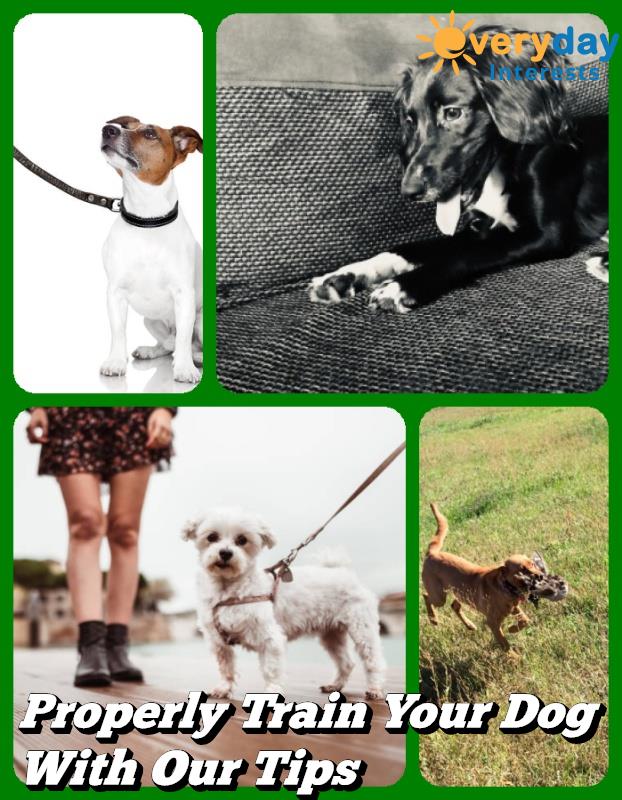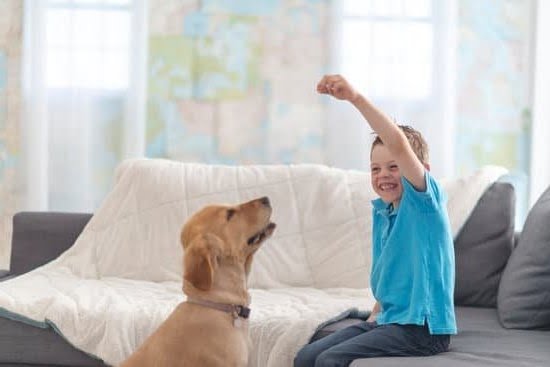Proper dog training is crucial for ensuring that you have a well-behaved pet. Training not only helps to establish boundaries and rules for your furry friend, but it also strengthens the bond between you and your dog. A well-trained dog can be a joy to own, providing companionship, protection, and even assistance in certain situations.
In this comprehensive guide on how to train a dog properly, we will delve into various aspects of dog training to give you the knowledge and tools you need to establish a strong foundation with your canine companion. From understanding dog behavior and choosing the right training gear to teaching fundamental commands and addressing unwanted behaviors, we will cover it all.
By using positive reinforcement techniques and effective strategies for correcting and redirecting unwanted behavior, you can shape your dog’s behavior in a way that promotes harmony within your home and community. Additionally, we will explore the importance of socialization, advanced training, troubleshooting common challenges, maintaining consistency in your training efforts, and fostering ongoing growth in your relationship with your dog.
With patience, consistency, and dedication, proper dog training can lead to a lifelong bond between you and your pet. The rewards of having a well-trained dog are limitless – from the freedom to take them anywhere without worry to the pride that comes with owning a four-legged companion who is polite, obedient, and brings joy to those around them. So let’s embark on this journey together as we unlock the secrets of successful dog training.
Understanding Dog Behavior
Understanding a dog’s behavior is crucial in training them properly. Canine psychology provides key insights into why dogs behave the way they do and how to effectively communicate with them. By understanding their natural instincts and drives, you can tailor your training methods to suit their needs, resulting in a more successful training experience.
One important aspect of understanding dog behavior is recognizing that dogs are pack animals by nature. This means that they have an inherent need to establish a hierarchy within their environment. As the owner, it is essential to establish yourself as the pack leader in order for your dog to respect and obey you. This can be achieved through consistent rules and boundaries, as well as providing clear communication and guidance.
Another important insight into canine psychology is the concept of positive reinforcement. Dogs thrive on praise, rewards, and attention from their owners. When a dog performs a desired behavior, such as sitting or staying on command, it is important to immediately reward them with treats or verbal praise. This reinforces the behavior in their mind and encourages them to repeat it in the future.
Additionally, understanding fear-based behaviors in dogs can greatly improve training outcomes. Many unwanted behaviors such as aggression or anxiety often stem from fear or insecurity. By identifying the triggers that elicit fear responses in your dog, you can work on desensitization and counter-conditioning techniques to help them overcome these fears.
Setting the Foundation
Establishing a strong bond with your dog is crucial for successful and effective training. This foundation of trust, respect, and communication will not only strengthen your relationship with your furry companion but also make the training process easier and more enjoyable for both of you. Here are some key points to consider when setting the foundation for a strong bond with your dog:
- Spend Quality Time Together: Dogs thrive on companionship and attention from their owners. Make sure to spend dedicated time each day engaging in activities that your dog enjoys, such as playing, going for walks, or simply cuddling on the couch. This will help foster a sense of companionship and create a positive association between you and your dog.
- Establish Clear Communication: Dogs need clear guidelines and boundaries to feel secure and understand what is expected of them. Use consistent verbal cues, body language cues, and hand signals to communicate with your dog effectively. Be patient and reinforce desired behaviors consistently so that your dog can understand what you want from them.
- Train Through Positive Reinforcement: Positive reinforcement techniques are highly effective in building trust and strengthening the bond with your dog. Rewarding good behavior with treats, praise, or playtime will motivate your dog to repeat those behaviors in the future while deepening the bond between you two.
To establish a strong bond with your dog, remember to be patient, consistent, and understanding throughout the training process. By investing time and effort into this foundation phase, you will lay the groundwork for future training success and enjoy a lifelong harmonious relationship with your four-legged friend.
Key Points
- Spending quality time together helps foster companionship.
- Clear communication through consistent cues helps dogs understand expectations.
- Positive reinforcement techniques strengthen the bond between you and your dog.
Essential Dog Training Tools
To ensure successful dog training, it is crucial to have the right tools and gear. The right equipment not only enables effective communication between you and your dog but also ensures their safety and comfort during training sessions. Here is a comprehensive guide to choosing the essential dog training tools:
Collars and Harnesses
Collars are commonly used for everyday walks and basic training exercises. The most common types include flat collars, martingale collars, choke collars, and prong collars. On the other hand, harnesses distribute pressure more evenly across a dog’s body and are ideal for dogs with respiratory issues or those prone to neck injuries.
Leashes
Leashes are essential for maintaining control over your dog during training sessions and walks. There are various types of leashes available, including standard leashes, retractable leashes, and long lines. It is important to choose a leash that suits your training needs and ensures your dog’s safety.
Clickers
Clicker training has gained popularity in recent years as an effective positive reinforcement technique. Clickers are small devices that produce a distinct sound when pressed. They are used to mark desired behaviors in real-time, which helps communicate effectively with your dog.
Treat Pouches or Bags
Treat pouches or bags enable easy access to rewards during training sessions. These accessories can be attached around your waist or carried in your pocket, ensuring convenience while rewarding good behavior promptly.
Interactive Toys
Interactive toys serve as both mental stimulation tools and rewards during training sessions. Toys such as puzzle feeders or treat-dispensing toys can keep your dog engaged while reinforcing positive behaviors.
The importance of selecting appropriate tools
When choosing dog training tools, it is important to consider your dog’s size, breed, personality, and training goals. Additionally, ensure that the tools are of good quality, comfortable for your dog to wear or use, and safe for both of you during training sessions. It is recommended to consult with a professional dog trainer or conduct thorough research before investing in any training equipment.
By using the right tools, you can effectively communicate with your four-legged friend and make their learning experience enjoyable. Remember that these tools are meant to aid in positive reinforcement training methods rather than exerting force or causing discomfort. When used correctly, appropriate training tools can contribute significantly to the success of your dog’s training and overall well-being.
Basics of Dog Training
When it comes to training your dog, teaching fundamental commands such as sit, stay, and come are essential for a well-behaved pet. These basic commands lay the foundation for more advanced training and help establish clear communication between you and your furry friend. In this section, we will explore effective techniques for teaching your dog these important commands.
One of the first commands that many dog owners teach their pets is “sit.” This command not only helps with impulse control but also encourages politeness when greeting people or other animals. To teach your dog to sit, start by holding a treat close to their nose while saying the word “sit” in a firm but friendly tone.
Slowly move the treat upwards towards the back of their head. As their head goes up following the treat, their bottom will naturally lower into a sitting position. Once they are in a sitting position, reward them with the treat and praise.
Another crucial command is “stay,” which is useful for keeping your dog safe in various situations. To train your dog to stay, begin with them in a sitting position. Hold your hand up flat with your palm facing towards them while saying “stay” firmly.
Take a step back while keeping eye contact with your dog. If they remain in place without moving towards you, reward them with praise and a treat. Gradually increase the distance and duration of the stay command as your dog becomes more comfortable with it.
It’s important to remember that consistency is key when teaching fundamental commands. Practice these commands daily in short sessions to reinforce what you have taught them. Always use positive reinforcement techniques such as treats, praise, or toys to reward good behavior during training. With time and patience, your dog will master these basic commands and set sail for more advanced training adventures.
| Command | Technique |
|---|---|
| Sit | Hold a treat close to their nose and slowly move it upwards towards the back of their head. Once they are in a sitting position, reward them with the treat and praise. |
| Stay | Begin with your dog in a sitting position. Hold your hand up flat with your palm facing towards them while saying “stay” firmly. Take a step back while keeping eye contact with your dog. If they remain in place without moving towards you, reward them with praise and a treat. |
Positive Reinforcement Techniques
Positive reinforcement techniques are essential in training a dog properly. By rewarding good behavior, you can encourage your dog to learn and follow commands effectively. Using positive reinforcement techniques not only strengthens the bond between you and your furry friend, but it also creates a positive and enjoyable training experience for both of you.
What is Positive Reinforcement?
Positive reinforcement involves providing rewards immediately after your dog performs a desired behavior. These rewards can include treats, praise, or even playtime with their favorite toy. The key is to make sure the reward is something that your dog finds valuable and motivating.
Why Choose Positive Reinforcement?
Positive reinforcement has been proven to be one of the most effective training methods for dogs. It fosters a positive learning environment by associating good behavior with rewards, making your dog more willing to repeat those behaviors in the future. This approach also helps build trust and confidence in your relationship with your pet.
By focusing on reinforcing wanted behaviors rather than punishing unwanted behaviors, positive reinforcement helps prevent fear and anxiety that may arise from using aversive training methods. It encourages dogs to engage in thinking and problem-solving, promoting mental stimulation as they work towards earning rewards.
How to Use Positive Reinforcement Techniques
When using positive reinforcement techniques, timing is crucial. The reward needs to come immediately after your dog performs the desired behavior so that they associate the two together. Be consistent in giving rewards every time your dog does something right to reinforce their understanding of what you expect from them.
Start by choosing a specific command or action that you want to train your dog on, such as sitting when asked. When they perform the desired behavior correctly, say a simple cue word like “sit” or use a clicker if you’ve been clicker training them. Then provide an immediate reward, such as a treat or praise accompanied by gentle pets.
Remember that every dog is unique, so find out what motivates your furry friend the most. For some dogs, treats will be the ultimate reward, while others may respond better to verbal praise or a favorite toy. Experiment with different rewards and learn what works best for your dog’s training progress.
By incorporating positive reinforcement techniques into your dog’s training routine, you can create a fun and enjoyable learning experience that will help them develop good behavior and obedience. Remember to be patient and consistent with your training efforts as it takes time for your dog to understand and master new commands.
Addressing Unwanted Behavior
Unwanted behavior is a common challenge that pet owners face when training their dogs. Whether it’s jumping, excessive barking, or chewing on household items, addressing and correcting these behaviors is crucial for a well-behaved dog. In this section, we will explore effective strategies for correcting and redirecting unwanted behavior in your canine companion.
Identifying the Root Cause
The first step in addressing unwanted behavior is to identify the root cause of the problem. Dogs may exhibit undesirable behaviors due to various reasons such as boredom, anxiety, fear, or even lack of proper training. By understanding the underlying cause, you can effectively address and correct the behavior.
Consistency and Positive Reinforcement
Consistency is key when it comes to correcting unwanted behavior. It’s important to establish clear rules and boundaries for your dog and ensure that everyone in the household follows them consistently.
Additionally, positive reinforcement techniques can be utilized to redirect your dog’s attention away from the unwanted behavior and towards an acceptable alternative. For example, if your dog tends to chew on furniture, providing them with appropriate chew toys and rewarding them when they engage with those toys can help redirect their chewing habits.
Redirecting and Distracting
Redirecting and distracting your dog from the unwanted behavior is another effective strategy. When you catch your dog engaging in undesirable actions, swiftly redirect their attention to something more appropriate. This could be a toy or a command that they are familiar with. By doing so, you are guiding their focus away from the undesired action towards a more desirable one.
Avoid Punishment-Based Training
While it may be tempting to resort to punishment-based training methods when dealing with unwanted behaviors, these techniques are generally not recommended as they can lead to fear or aggression in dogs. Instead of punishing your pet for undesired actions, focus on reinforcing positive behaviors and providing them with an environment that encourages good behavior.
Socialization
Socialization is a crucial aspect of dog training that often gets overlooked. It involves exposing your dog to various environments, situations, and people in order to help them feel more confident and comfortable in different settings. By socializing your dog properly, you can greatly reduce the risk of behavior problems and anxiety later in life.
Why is Socialization Important?
Socializing your dog plays a key role in their overall well-being and development. When dogs are exposed to new experiences and learn how to navigate different environments, they become more adaptable and resilient. This helps them handle changes and unfamiliar situations with ease, reducing the likelihood of fear or aggression.
Furthermore, socialization helps prevent common behavior problems such as excessive barking, chewing, or destructive behavior. Dogs that have been properly socialized are less likely to exhibit these problematic behaviors because they have learned how to cope with stressors in a healthy way.
How to Socialize Your Dog
When it comes to socializing your dog, it’s important to start early. Puppies are most receptive to new experiences between 3 and 14 weeks of age, so introducing them to different people, animals, sights, sounds, and smells during this critical period is essential. However, older dogs can still benefit from proper socialization.
Begin by gradually exposing your dog to various environments such as parks, busy streets, or outdoor cafes. Observe their reactions carefully and reward calm behavior with treats or praise. As your dog becomes more comfortable in these settings, gradually increase the level of challenge by introducing them to different people and dogs.
It’s important to remember that each dog is unique and may have specific sensitivities or fears. Take it slow and work at your pet’s pace. If they show signs of fear or discomfort in a certain situation, do not force them into it. Instead, allow them time to adjust before trying again.
Ensuring Positive Experiences
To maximize the benefits of socialization, it’s crucial to ensure that each experience is positive for your dog. This means keeping interactions controlled and safe, and providing plenty of rewards and praise when your dog behaves well.
You can also consider enrolling your dog in puppy classes or joining socialization groups where they can interact with other dogs in a supervised setting. These controlled environments provide an opportunity for proper social interaction and further reinforce positive behavior.
Remember, proper socialization is an ongoing process. Continually expose your dog to new experiences throughout their life to help them stay confident and well-adjusted in different situations. By investing time in socializing your dog, you are setting the foundation for a happier, more balanced pet that can accompany you on all of life’s adventures.
Advanced Training
Taking your dog’s training to the next level involves building upon the basic commands and behaviors they have already learned. This advanced training is not only mentally stimulating for your dog, but it also strengthens your bond and provides them with additional skills to navigate various situations. Here are some key areas to focus on when advancing your dog’s training:
1. Advanced Commands: Once your dog has mastered basic commands like sit, stay, and come, you can introduce more complex commands such as heel, fetch, or play dead. These commands require more concentration and coordination from your dog, helping to challenge their cognitive abilities.
2. Specialized Training: If you have specific goals for your dog, advanced training can help you achieve them. Whether it’s agility training, scent detection, or search and rescue work, specialized training allows your dog to excel in a particular skill set and fulfill their potential.
3. Off-Leash Training: Teaching your dog to obey commands while off-leash requires an advanced level of control and trust. Start by practicing in a safe and secure environment before gradually increasing distractions. Always prioritize safety when attempting off-leash training.
To effectively advance your dog’s training, remember these important principles:
1. Patience: Advanced training takes time and consistency. Be patient with yourself and your dog as you both learn new skills together.
2. Positive Reinforcement: Continue using positive reinforcement techniques to motivate and reward your dog for their progress. Treats, praise, and playtime are all effective ways to reinforce good behavior.
3. Consistency: Consistency is crucial in advanced training. Maintain a regular schedule of practice sessions to reinforce what your dog has learned and ensure that they don’t regress in their training.
| Advanced Training Benefits |
|---|
| – Mental stimulation and enrichment for your dog |
| – Strengthened bond between you and your dog |
| – Enhanced control and obedience in various situations |
Troubleshooting Common Training Challenges
One of the biggest hurdles that dog owners face during the training process is dealing with common challenges that can arise. While every dog and training situation is unique, there are certain issues that tend to be more common and require specific strategies for resolution. By understanding these challenges and having a plan in place to address them, you can navigate through the training process more effectively.
One common challenge that dog owners face is difficulty in housebreaking their pets. Potty training can be a frustrating process, but with patience and consistency, it can be overcome. One strategy is to establish a routine for your dog, taking them outside at regular intervals throughout the day and immediately after meals or naps. Rewarding your dog each time they eliminate outdoors reinforces the desired behavior and helps them understand where they should go.
Another challenge may arise when teaching your dog to walk politely on a leash. Many dogs naturally want to pull or lunge forward, making walks unpleasant and difficult for both you and your four-legged companion. To address this issue, consider using positive reinforcement techniques such as rewarding your dog with treats or praise whenever they exhibit good leash manners. Additionally, using proper equipment like a front-clip harness or head halter can help discourage pulling behavior.
| Common Training Challenge | Troubleshooting Strategy |
|---|---|
| Housebreaking difficulties | – Establish a consistent routine for potty breaks
|
| Pulling on the leash | – Use positive reinforcement techniques
|
Addressing unwanted behaviors such as excessive barking or jumping up on people are also common challenges during training. To tackle these issues, it is important to identify the root cause of the behavior and address it appropriately.
For example, excessive barking may be a result of boredom or anxiety, so providing mental stimulation through toys or puzzles can help redirect their energy. Jumping up can be managed by teaching your dog an alternative behavior like sitting when greeting people, and rewarding them for that instead.
By being proactive and prepared to face common training challenges, you can ensure a smoother and more successful training process for both you and your dog. Remember to stay patient, consistent, and always use positive reinforcement techniques to encourage good behavior. With time and effort, you will overcome any hurdles and build a strong bond with your well-trained pet.
Maintaining Consistency
Consistency is key when it comes to training your dog. Creating a training schedule and sticking to it is essential for effective and efficient training. Dogs thrive on routine, and having a consistent schedule helps them understand what is expected of them and promotes better learning. In this section, we will explore the importance of maintaining consistency in dog training and provide tips on how to create a training schedule that works for both you and your furry friend.
One of the main reasons why consistency is crucial in dog training is because it helps reinforce the desired behaviors. Dogs learn through repetition, and by consistently practicing commands or routines, you are reinforcing the behavior you want from your dog. If you are inconsistent in your training efforts, your dog may become confused or frustrated, making it harder for them to understand what you want from them.
To create a training schedule, start by determining how much time you can dedicate to training each day. Consistency doesn’t necessarily mean spending hours each day; even short, regular sessions can be effective. Divide your available time into smaller sessions throughout the day to prevent both you and your dog from becoming overwhelmed or fatigued. Remember that dogs have shorter attention spans, so shorter sessions are often more productive than long ones.
When creating a schedule, be sure to set aside specific times for training sessions. This will help establish a routine for both you and your dog. Consider incorporating training into your daily activities as well – for example, practice commands during walks or incorporate them into playtime sessions. Consistency doesn’t just apply to when you train; it also includes where you train. Find a designated area free from distractions where you can focus on training without interruptions.
Building a Lifelong Bond
Training your dog is not just about teaching them obedience; it is also an opportunity to further strengthen the bond between you and your furry companion. By consistently working on training techniques, you can foster ongoing growth in your relationship with your dog and develop a lifelong bond based on trust and understanding.
One way to foster ongoing training and relationship growth is through regular practice sessions and continued learning. Once your dog has mastered basic commands, such as sit, stay, and come, it’s important to continue challenging them with new skills and commands. This not only keeps their minds engaged but also allows you to deepen the connection you have with your dog as you work together towards new goals.
Another aspect of ongoing training is incorporating real-life scenarios into your training sessions. For example, practicing recall commands in a park or teaching your dog how to behave on walks can help reinforce positive behaviors in different environments. By exposing them to various situations, you are not only expanding their boundaries but also building trust that they can rely on you for guidance no matter where you are.
In addition to regular training sessions, bonding with your dog outside of formal training activities is crucial for fostering a lifelong bond. Engaging in activities such as playtime, exercise, and quality time spent together can solidify the connection between you and your furry friend. Whether it’s going for hikes, playing fetch at the park, or simply cuddling on the couch, these moments create positive associations and build trust between both of you.
By continuously investing time and effort into training and building a bond with your dog, you will reap the rewards of a well-behaved pet who understands their role within your family dynamic. Not only will this make day-to-day life more enjoyable for both of you, but it will also strengthen the overall happiness and fulfillment found within the human-dog relationship.
Remember, fostering ongoing training and relationship growth is a lifelong commitment that requires patience, consistency, and a genuine desire to create a harmonious partnership with your furry friend.
Conclusion
Training a dog properly is not just about teaching them commands and tricks, but it is about fostering a strong bond between you and your pet. Throughout this article, we have learned the importance of understanding dog behavior, establishing a foundation of trust, using positive reinforcement techniques, addressing unwanted behavior effectively, and maintaining consistency in training. All of these elements come together to create a well-behaved dog and a joyful experience for both owner and pet.
The rewards of properly training your dog are numerous. Firstly, it allows for better communication between you and your furry friend. When you have established a strong bond and taught them fundamental commands, you can navigate daily life more easily together. This means fewer instances of miscommunication or confusion, leading to many happy experiences as a pet owner.
Furthermore, a well-behaved dog is a joy to be around. They will be welcomed by others when they display good manners in different environments and around other people or animals. Properly trained dogs also tend to be happier overall because they know what is expected of them and how to fulfill those expectations. As an owner, seeing your companion thrive in social situations and behave appropriately gives immense satisfaction.
In conclusion, training your dog properly is essential for both their well-being and the enjoyment of owning a pet. It strengthens the bond between you two and creates an environment where communication flows smoothly.
The consistent use of positive reinforcement techniques creates lasting habits while addressing unwanted behaviors effectively ensures harmony at home or in public spaces. Ultimately, the rewards of proper dog training extend beyond obedience; they bring immeasurable joy through nurturing lifelong bonds with our beloved four-legged friends.
Frequently Asked Questions
What are the 5 golden rules of dog training?
The 5 golden rules of dog training are fundamental principles that guide effective training techniques. Firstly, consistency is key in establishing clear expectations and boundaries for the dog. Secondly, positive reinforcement should be used to reward desired behaviors, such as treats or praise, instead of punishment for unwanted behaviors.
Thirdly, patience is essential as dogs require time to learn and adapt to new commands or routines. Fourthly, maintaining a calm and assertive demeanor helps establish leadership and build trust with the dog. Lastly, proper socialization is crucial to ensure that the dog interacts well with people and other animals.
How do you train a dog successfully?
Successful dog training involves several important steps. Firstly, setting clear goals and objectives is necessary so that both the owner and the dog have a shared understanding of what needs to be achieved. Secondly, creating a structured routine with consistent rules helps establish boundaries and prevent confusion for the dog.
Thirdly, positive reinforcement should always be used to reward desired behaviors promptly and effectively communicate to the dog what it did correctly. Additionally, using clear verbal commands accompanied by hand signals can enhance communication between the owner and the dog during training sessions. Finally, it is important for owners to dedicate time and patience to ongoing training efforts as dogs require consistency and repetition to learn successfully.
What is the most effective method of dog training?
While there are various methods of dog training available, some may argue that positive reinforcement training is often considered one of the most effective approaches for teaching dogs new behaviors or modifying existing ones. This method focuses on rewarding desired actions using treats, praise, or playtime instead of relying on punishment or correction-based techniques when unwanted behaviors occur.
By using positive reinforcement consistently and promptly after appropriate behavior is displayed, dogs are more likely to associate certain actions with positive outcomes leading them to repeat those actions in order to receive rewards again in future instances. Positive reinforcement not only encourages dogs but also helps build a strong bond between pet owners and their furry companions based on trust and mutual respect.

Welcome to the blog! I am a professional dog trainer and have been working with dogs for many years. In this blog, I will be discussing various topics related to dog training, including tips, tricks, and advice. I hope you find this information helpful and informative. Thanks for reading!





